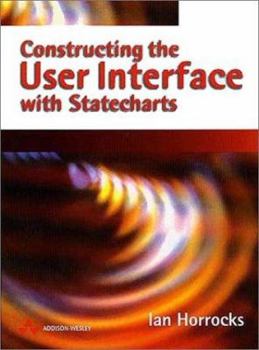Constructing the User Interface with Statecharts
Teaches the reader how to design, implement and test high quality user interface software. The text describes a single, simple and generic technique using Statecharts that can be used with any... This description may be from another edition of this product.
Format:Paperback
Language:English
ISBN:0201342782
ISBN13:9780201342789
Release Date:January 1999
Publisher:Addison-Wesley Professional
Length:272 Pages
Weight:0.85 lbs.
Dimensions:0.6" x 6.7" x 9.2"
Customer Reviews
5 ratings
Note the CONSTRUCTING and not Designing
Published by Thriftbooks.com User , 23 years ago
It is important to realize that this book is not about designing user interfaces. It states that quite clearly in the beginning and with a title like this it is not suppose to be. The book assumes that you know some user interface design principles and are applying them in the general screen designs. Although it is fine that the book assumes you have the design skills, it is unfortunate that it in its examples does not use better design skills. Some of the screens/forms that are constructed in the book could also serve as good examples of how not to apply design knowledge - although there probably are worse. The author makes it clear that the book is not about the design of screens, but using well-designed screens as examples wouldn't hurt. It is however not big enough of a problem to degrade the star rating.From a practical point of view the approach suggested in this book is very usable. Although one may design a complete system in this way, it will also serve useful in sub-systems and even individual screens. In essence this book deals with the problem that programmers started to face when event-driven programming became the norm. Before event-driven programming could predict the order in which pieces of program code are going to run. With event-driven program the events may happen in any unpredictable order. For the user interface designer this presents challenging problems regarding the currency and consistency of the user interface. This is the main problem addressed in this book.The approach is based on splitting the presentation issues in two layers: user interface objects and control objects that manages the behavior of the user interface objects. In essence the modeling of the control objects are done using state charts.A clear description of the approach is given. The handling of state charts is pretty much inline with state charts in UML although certain "customisations" are being introduced to cater for specific requirements. These are, however, fundamentally sound. The nicest aspect I suppose is that the book doesn't get stuck on the semantic aspects of state charts but provides very practical examples of how it can be used to model the behavioural dynamics of systems.I found the book easy to read, especially as far as the basics are concerned. It is divided into four parts. Part 1, represented by chapters 1 - 5 (57 pages) deals with motivating the need for such an approach. Chapters 6 - 9 (Part 2) introduces the notational aspects of the approach in a reasonably condensed 50 pages. Part 3 consist of three chapters that provides the state chart designs for three case studies. Part 4 (Chapters 13 - 15) deals with how to take this from state chart notation to physical code - in my opinion the crux of the problem. Several appendices are used to give more detail on the case studies presented in the book - a fact that certainly helps with the readability of the book.I managed to convert the "code examples" given with
One of a kind
Published by Thriftbooks.com User , 25 years ago
In modern systems more than half of the development effort - sometimes upto 90% of the effort - goes into implementing user interfaces. Remarkably, this is one of the very few books that provides significant coverage of user interface design and implementation. It brings a much needed rigour to user interface construction that other authors have ignored.
Makes coding easy
Published by Thriftbooks.com User , 25 years ago
The technique described in this book is great. I used it to design a java applet recently and I found it reduced coding to a trivial task. The power of the technique lies in specifying the "syntax of interaction" before the user interface is coded.I strongly recommend this book.
A unique book on designing presentation layer objects
Published by Thriftbooks.com User , 25 years ago
Most business systems are split into several layers, typically: Presentation objects, Business objects, and Data objects. Most object oriented design books focus on the objects in the business layer and the data layer. This book is different because it is entirely focused on the presentation layer. The book describes how the presentation layer split into two layers: user interface objects and control objects. The book provides several case studies that show how to design the control objects using statecharts. The statcharts provide a precise description of how the user can interact with the system.
A brilliant book
Published by Thriftbooks.com User , 25 years ago
This book makes developing user interfaces incredably easy. Using statecharts to capture the behaviour of a user interface before any code is written is such an obvious idea that I can't believe it hasn't been written about before.Forget about Use Cases, use statecharts instead because they can be converted directly into code.





